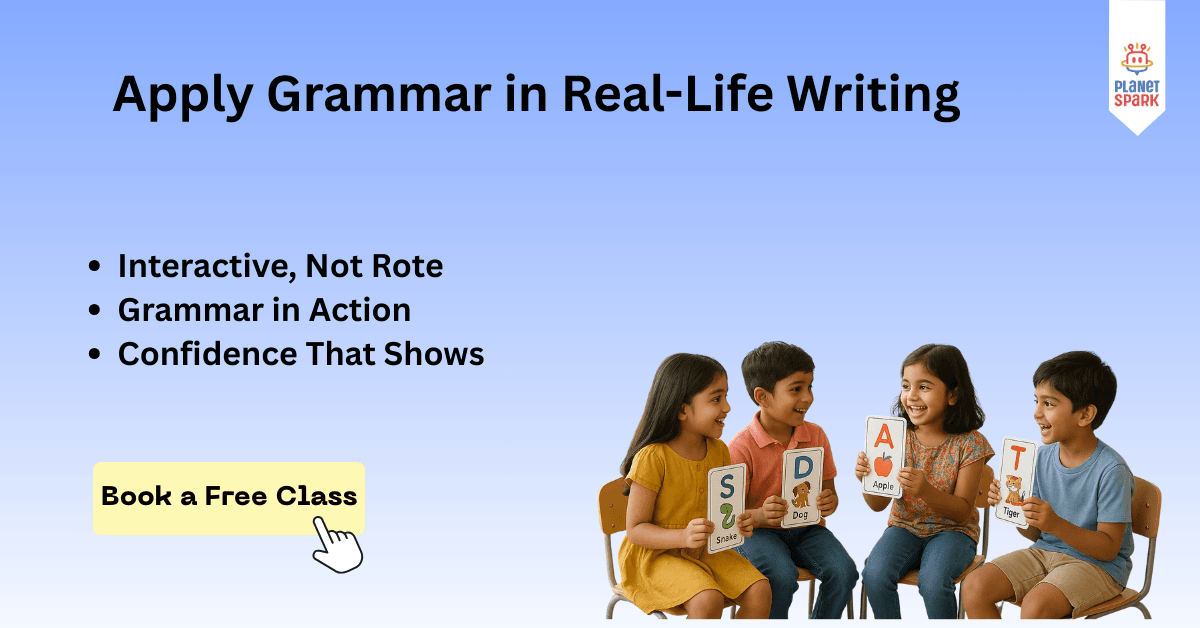Coordinating Conjunctions: Definition, Examples, and Usage Guide

Table of Contents
- What is a Coordinating Conjunction?
- List of Coordinating Conjunctions (FANBOYS)
- Coordinating Conjunction Examples
- Rules for Using Coordinating Conjunctions
- Coordinating and Subordinating Conjunctions – Key Difference
- Coordinating Conjunction Worksheets and Practice
- Common Mistakes with Coordinating Conjunctions
- Why Mastering Coordinating Conjunctions is Important
- Additional Resources on Conjunctions
- Learn English Grammar with PlanetSpark
- Frequently Asked Questions (FAQs)
Language is built on connections. Every sentence we write or speak relies on words that link ideas together in a smooth and meaningful way. Among these connecting words, coordinating conjunctions play one of the most important roles. They allow us to join words, phrases, and even entire sentences without making our writing awkward or repetitive.
So, what are coordinating conjunctions? In simple terms, they are words that join similar elements together. They can link two nouns, two verbs, two phrases, or even two independent clauses. Without them, our language would be fragmented, and communication would feel incomplete. In this blog, we will explore coordinating conjunctions in depth: their definition, rules, list, examples, differences from subordinating conjunctions, worksheets for practice, and common mistakes. By the end, you’ll understand how to use them correctly and confidently.
Book a free trial class today and let your child explore grammar in a fun way.
What is a Coordinating Conjunction?
A coordinating conjunction is a word that connects two equal parts of a sentence. The word “equal” here means that the elements being connected are of the same type or grammatical rank. For instance:
She likes coffee and tea.
We waited, but they never arrived.
You can stay here, or you can come with me.
In all these cases, the conjunction connects similar elements: nouns, clauses, or verbs. Unlike subordinating conjunctions, which connect a dependent clause to an independent one, coordinating conjunctions always link two elements that can stand independently.
Simple Definition: A coordinating conjunction is a joining word that connects words, phrases, or clauses of equal importance in a sentence.

List of Coordinating Conjunctions (FANBOYS)
Most students remember coordinating conjunctions through the FANBOYS acronym:
For – explains reason or purpose
And – adds one idea to another
Nor – presents a negative choice
But – shows contrast
Or – presents an option or choice
Yet – shows contrast (similar to “but”)
So – shows effect or result
These seven words form the complete list of coordinating conjunctions in English. Let’s look at each one with examples.
For: I stayed home, for I was feeling sick.
And: She bought apples and bananas.
Nor: He did not call, nor did he send a message.
But: The movie was long, but very entertaining.
Or: Do you want coffee or tea?
Yet: He is rich, yet he is not happy.
So: It was raining, so we stayed indoors.
Enroll now and give your child the confidence to write and speak fluently.
Coordinating Conjunction Examples
Examples help us understand how coordinating conjunctions work in real-life sentences.
Examples in sentences:
I wanted to go out, but it was too late.
You can either call me or send an email.
She is smart, and she is hardworking.
He didn’t apologize, nor did he try to explain.
We were tired, so we went to bed early.
Notice that each sentence could be broken into smaller sentences, but the conjunction allows them to be combined for smoother flow.
Rules for Using Coordinating Conjunctions
Coordinating conjunctions may look simple, but there are important rules to remember:
1. Connect Equal Parts
They must connect words, phrases, or clauses of the same kind.
Correct: She likes to dance and sing.
Incorrect: She likes to dance and singing.
2. Joining Independent Clauses
When a coordinating conjunction connects two independent clauses, use a comma before it.
Correct: We wanted to go for a walk, but it started raining.
Incorrect: We wanted to go for a walk but it started raining.
3. Avoiding Run-On Sentences
Never join independent clauses with just a conjunction but without proper punctuation.
4. Using in Lists
“And” and “or” are often used to connect items in a list.
We bought apples, oranges, and bananas.
Coordinating and Subordinating Conjunctions – Key Differences
It’s easy to confuse coordinating and subordinating conjunctions. Here’s the difference:
Coordinating Conjunctions: Link equal ideas (two main clauses).
Subordinating Conjunctions: Link a dependent idea to a main clause.
Examples:
Coordinating: I wanted to go swimming, but it was too cold.
Subordinating: I wanted to go swimming because it was hot.
The first sentence has two independent clauses, while the second sentence has one independent clause and one dependent clause.
Sign up for PlanetSpark’s English Grammar Course and make learning interactive.
Coordinating Conjunction Worksheets and Practice
Here are a few practice exercises to test your understanding.
Fill in the blanks:
He was tired, ___ he continued working.
I like pizza ___ pasta.
She does not like coffee, ___ does she like tea.
Answer Key:
but
and
nor
Combine the sentences using conjunctions:
She is kind. She is generous.
Do you want to play cricket? Do you want to play football?
Answer:
She is kind and generous.
Do you want to play cricket or football?
Common Mistakes with Coordinating Conjunctions
Overuse – Using too many conjunctions makes writing messy.
Incorrect: I like pizza and pasta and ice cream and chocolate and fries.
Better: I like pizza, pasta, ice cream, chocolate, and fries.
Missing comma before conjunction when joining clauses.
Incorrect: I wanted to go shopping but the store was closed.
Correct: I wanted to go shopping, but the store was closed.
Confusing with subordinating conjunctions – Remember that words like because, although, since are not coordinating.

Why Mastering Coordinating Conjunctions is Important
They improve writing fluency and make ideas flow logically.
They help students write longer, more meaningful sentences.
They are tested in grammar exams, competitive exams, and schoolwork.
They are essential in spoken English for expressing ideas clearly.
For children especially, mastering coordinating conjunctions is a crucial step toward building complex sentence structures.
Help your child build a strong foundation in English – book a demo class now.
Additional Resources on Conjunctions
You may also want to explore:
[Types of Sentences – Simple, Compound, and Complex] (internal link placeholder)
[Subordinating Conjunctions Guide] (internal link placeholder)
[Personal Pronouns in English] (internal link placeholder)
For deeper understanding, external references like Cambridge Dictionary or Grammarly Blog can also be helpful.
Coordinating conjunctions may look like small words, but they have a powerful impact on sentence structure and clarity. By mastering FANBOYS and applying the rules correctly, learners can build strong communication skills. From connecting simple words to joining complex ideas, coordinating conjunctions are essential tools in English grammar.
Start practicing today with the worksheets provided above, and explore more grammar resources with PlanetSpark to make learning interactive and fun.

Learn English Grammar with PlanetSpark
At PlanetSpark, grammar becomes simple, interactive, and engaging. Our English Grammar Course helps kids understand tricky topics like coordinating conjunctions through real-world practice, fun activities, and expert guidance.
Why Choose PlanetSpark? (USPs)
Interactive, not boring – Kids don’t just memorize grammar rules, they apply them in games, stories, and speaking activities.
Designed for kids – Every lesson is child-friendly, structured in a way that makes learning fun and effective.
Expert-certified teachers – Experienced educators make sure kids learn with clarity and confidence.
Proven results – Thousands of parents trust PlanetSpark for improved grammar, writing, and communication skills.
Key Features of PlanetSpark’s Grammar Course
Live interactive classes with certified teachers
Fun worksheets, quizzes, and grammar games for hands-on learning
Real-world speaking and writing practice to build confidence
Personalized attention in small batches for focused progress
Regular progress tracking for parents through detailed reports
Comprehensive coverage of English grammar topics – from basics like nouns and pronouns to advanced sentence structures
Engaging storytelling and role-play activities that make grammar easy to remember
Flexible online learning platform accessible from home
Book a free trial class today and let your child explore grammar in a fun way.
Frequently Asked Questions (FAQs)
Q1. What are coordinating conjunctions?
Coordinating conjunctions are words like for, and, nor, but, or, yet, so that connect words, phrases, or clauses of equal importance in a sentence.
Q2. How many coordinating conjunctions are there in English?
There are seven coordinating conjunctions in English, commonly remembered through the acronym FANBOYS – For, And, Nor, But, Or, Yet, So.
Q3. What is the difference between coordinating and subordinating conjunctions?
Coordinating conjunctions connect two independent clauses or equal sentence parts, while subordinating conjunctions connect a dependent clause to an independent clause.
Q4. Can a sentence start with a coordinating conjunction?
Yes, it is acceptable to start a sentence with a coordinating conjunction like But or And, especially in modern writing styles. However, it should not be overused.
Q5. What are some examples of coordinating conjunctions in sentences?
She was tired, but she finished her homework.
We can go shopping, or we can stay home.
He is smart and hardworking.
Q6. Why are coordinating conjunctions important in grammar?
They help create smoother, clearer sentences by linking related ideas. Without them, writing would feel choppy and disconnected.
Q7. Are there worksheets to practice coordinating conjunctions?
Yes, students can practice through fill-in-the-blank activities, combining sentences, and multiple-choice exercises to strengthen their grammar skills.
Download Free Worksheets
Personalized Communication Report
Record a video to get a AI generated personalized communication report for your child

Hi There, want to try these
tips for your child with
LIVE with our expert coach?
Let's check your child's
English fluency

